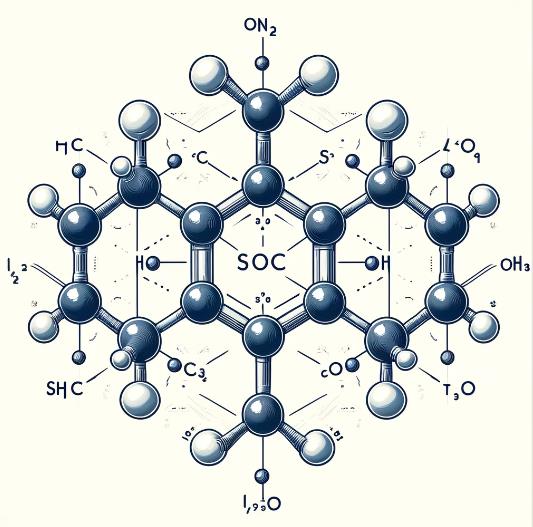The Rise of Silane, (3-isocyanatopropyl)dimethoxymethyl: A Closer Look at Its Synthesis, Composition, and Applications
May 6,2024
Introduction
In the world of chemical innovations, certain compounds stand out due to their unique properties and potential applications. One such compound is Silane, (3-isocyanatopropyl)dimethoxymethyl, a specialized molecule gaining attention in the chemical industry for its versatility and efficiency in various applications. This compound, characterized by its structural complexity and reactive nature, serves as a pivotal component in advanced material science. Researchers and industrial chemists are drawn to its potential for creating more durable and resilient materials, thus opening new avenues for development in coatings, adhesives, and sealants. Its rising prominence underscores the continual evolution and specialization in chemical synthesis, highlighting its role in meeting the demands of modern technological challenges[1].

Figure 1 Molecular structure diagram of Silane,(3-isocyanatopropyl)dimethoxymethyl
Synthesis
The synthesis of Silane, (3-isocyanatopropyl)dimethoxymethyl, is a testament to the advances in chemical engineering techniques. This compound is typically synthesized through a multi-step reaction process that involves the careful manipulation of silane chemistry. The initial step usually involves the reaction of a suitable silane precursor with dimethoxymethane under controlled conditions. Following this, an isocyanate functional group is introduced through a reaction with an alkyl isocyanate, such as isocyanatopropyl, under the presence of a catalyst.
This process not only requires precise control over reaction conditions such as temperature and pressure but also the use of specific catalysts that can promote the reaction without decomposing the intermediate products. The synthesis method demonstrates the complexity and the precision required in the production of advanced chemical compounds.
Main Components
Silane, (3-isocyanatopropyl)dimethoxymethyl, consists of several key components that define its chemical behavior and functionality. The silane base provides a robust backbone that is highly reactive with various substrates due to the presence of silicon. This reactivity is further enhanced by the dimethoxymethyl groups, which offer additional sites for reactions, particularly with alcohols and water, leading to cross-linking abilities.
The isocyanatopropyl group is another critical component of this compound. This functional group is renowned for its reactivity with nucleophiles, particularly amines, and alcohols, which allows it to form urethanes and urea derivatives. These reactions are crucial for applications in polymers and coatings where durability and chemical resistance are required.
Applications
The applications of Silane, (3-isocyanatopropyl)dimethoxymethyl, are vast and varied. In the coatings industry, it is used as a cross-linking agent that improves the adhesion and durability of paints and varnishes on different substrates, including metals, glass, and plastics. Its use in the automotive and aerospace industries is particularly noteworthy, where performance and longevity of materials are paramount.
Additionally, this compound finds applications in the manufacture of sealants and adhesives. The unique chemical structure of Silane, (3-isocyanatopropyl)dimethoxymethyl, allows for the formulation of products that are exceptionally resistant to weathering, chemicals, and heat, making it ideal for outdoor and industrial applications[2].
Storage Methods
Storing Silane, (3-isocyanatopropyl)dimethoxymethyl, requires careful consideration due to its reactivity and sensitivity to moisture. It is typically stored in airtight containers under an inert atmosphere, often nitrogen, to prevent unwanted reactions with atmospheric moisture. The storage area should be well-ventilated, cool, and dry to maintain the stability of the compound over time. Additionally, proper labeling and adherence to safety standards are crucial to ensure the safe handling and storage of this chemical.
Conclusion
Silane, (3-isocyanatopropyl)dimethoxymethyl, represents a significant advancement in the field of silane chemistry. With its complex synthesis, unique composition, and a broad range of applications, it offers great potential for enhancing the performance of materials across various industries. As research continues and its applications expand, Silane, (3-isocyanatopropyl)dimethoxymethyl, is poised to play a crucial role in the development of new materials and technologies. Its storage and handling, though requiring careful attention, underscore its importance and the need for stringent control measures to harness its full potential safely and effectively[3].
References
[1]Sterman S, Marsden J G. Silane coupling agents[J]. Industrial & Engineering Chemistry, 1966, 58(3): 33-37.
[2]Witucki G L. A silane primer: chemistry and applications of alkoxy silanes[J]. Journal of coatings technology, 1993, 65: 57-57.
[3]Xie Y, Hill C A S, Xiao Z, et al. Silane coupling agents used for natural fiber/polymer composites: A review[J]. Composites Part A: Applied Science and Manufacturing, 2010, 41(7): 806-819.
- Related articles
- Related Qustion
- The introduction of Silane, (3-isocyanatopropyl) dimethoxymethyl Feb 1, 2023
The Silane, (3-isocyanatopropyl) dimethoxymethyl, with the CAS No: 26115-72-0, is also known as γ-isocyanatopropylmethyl dimethoxysilane. This chemical’s molecular formula is C7H15NO3Si.
Calcitriol is an active metabolite of vitamin D and a vitamin D receptor (VDR) agonist.....
May 6,2024Vitamins and Minerals medicinesPyridinium p-toluenesulfonate is a versatile catalyst, enabling efficient synthesis of chiral compounds with high selectivity and facilitating key chemical processes.....
May 6,2024APISilane,(3-isocyanatopropyl)dimethoxymethyl
26115-72-0You may like
Silane,(3-isocyanatopropyl)dimethoxymethyl manufacturers
- 3-Isocyanatopropylmethyldimethoxysilane
-

- $0.00 / 1kg
- 2024-07-15
- CAS:26115-72-0
- Min. Order: 0.1kg
- Purity: 96%
- Supply Ability: 800tons
- Silane,(3-isocyanatopropyl)dimethoxymethyl
-

- $100.00 / 25kg
- 2023-01-31
- CAS:26115-72-0
- Min. Order: 1kg
- Purity: 99%
- Supply Ability: 50000KG/month
- Silane,(3-isocyanatopropyl)dimethoxymethyl
-

- $10.00 / 1KG
- 2022-09-27
- CAS:26115-72-0
- Min. Order: 1KG
- Purity: 99%
- Supply Ability: 10 mt




